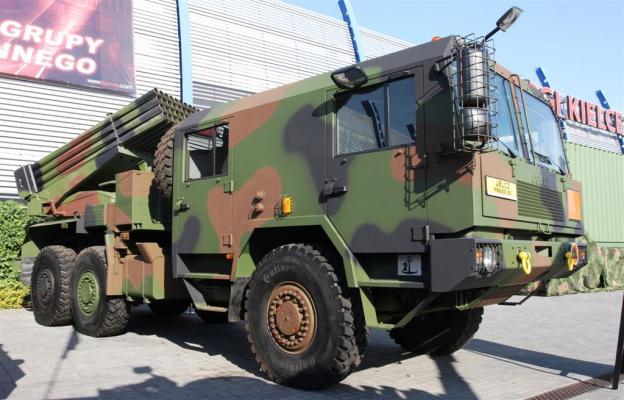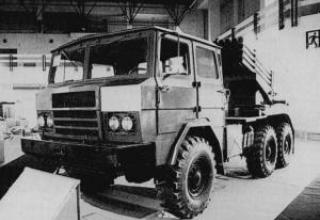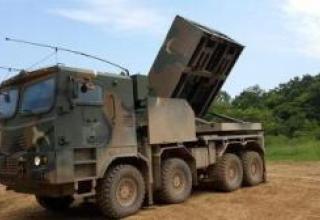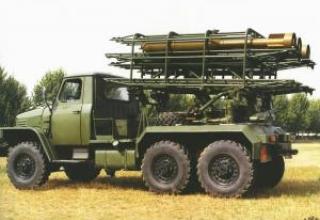The Polish army was quite a combat vehicle BM-21, but the chassis "Ural-375D" is becoming outdated, it's harder to buy spare parts, and every year, the reduced in number Polish army is forced to limit the types of vehicles. Because of this, it was decided to start searching for a new chassis for the combat vehicle BM-21 RSZO 9K51 "Grad", which is in service with the Polish army in the amount of 225 pieces (data of 2008. It is not known whether this figure represents the number of BM remaining after the modernization or the number that was before it).
The prototype of the new fighting vehicle (VM) was developed by Huta Stalowa Wola in 2000 with its own funds. The artillery part, removed from the standard chassis, was mounted on the modified chassis of the truck Star 1466 6×6 made in Poland (photo by T.Schulz© Poland) - then the standard medium vehicle of the Polish Army. Specialists from WB Electronics developed a new fire control system, which can work in conjunction with other Polish artillery and mortar systems. The result of the work was an automated combat vehicle. Unfortunately, the Polish Ministry of Defence was not interested in such a proposal (at that time, the possibility of switching to the American MLRS system was most often discussed). Then, the manufacturer of Star vehicle failed - German company MAN decided to stop production of military trucks in Poland.
I had to look for another chassis. The decision was made in favor of another Polish car manufacturer - the company Jelcz (Jelcz). The result of these works was an automated combat vehicle, designated WR-40 Langusta (photo M.Duroshi© Slovakia) . Artillery part of BM WR-40 is mounted on a modified chassis of truck Jelcz P662D.35 6×6.
Combat vehicle WR-40 Langusta was adopted by the Polish Army, in 2008 it was shown at the military parade in Warsaw (see photo). Different versions of the combat vehicle were repeatedly exhibited at the MSPO international defense industry exhibitions (see the WR-40 Langusta BM image gallery at the 18th International Defence Industry Exhibition MSPO 2010 (Kielce, Poland).
Unmanned 122 mm caliber rockets are designed for firing from the WR-40BM. The first Polish upgrades of the 122 mm unguided rockets began in the mid-1980s with the development of an accurate non-contact fuse. Then the development of a cassette head unit in equipment with cumulated shrapnel warheads and anti-personnel mines was set. These works were not completed until the collapse of the Warsaw Pact organization and continued in the 1990s.
The development of the extended range Unmanned Rocket Launcher (NURS), designated Feniks-Z, began in 1996 as a joint project between Polish Tlocznia Metali Pressta SA from Bolehovo (production of Unmanned Rocket Launcher) and French company Celerg (now Roxel) (a rocket engine with a mixture of solid fuel). Under an agreement in 1996, TM Pressta SA produced 50% of the RDTT. Recall that the French company Celerg at that time also worked with the Russian side in the same direction on the 122 mm caliber shells with extended range and new types of head units.
Tactical and technical specifications were tested at Zagan training ground in August 2001. According to the results of the tests, the heap rate of fire of the NURS Feniks-Z at a range of 33,000 m was at the same level as that of the old Soviet-designed NURS M-21OF (index 9M22U) at a range from 18,000 to 20,000 meters. The new unguided projectile can be fired from BM-21, RM-70 and similar combat vehicles. As stated by the manufacturer representative, the projectile "is ten times more effective than the old NURS, but five times more expensive". After the tests, the Polish Ministry of National Defence ordered a batch of several hundred Feniks-Z NURS for final testing by the customer. The small-scale production was organised by the end of March 2003. The Supply Department of the Polish Ministry of National Defence and Tlocznia Metali Pressta (TM Pressta), located in Bolehovo, agreed and signed the first contract for large-scale production of Feniks-Z 122 mm caliber unguided rockets. The value of the contract is estimated at approximately PLN 20 million (EUR 4.26 million), and delivery of the first 500 NURS should have been made by the end of 2004. Between 1994 and 2002 TM Pressta delivered about 20,000 unguided rockets.
At the end of 2003, a new industrial organization, the Factory of Special Production (FSP), was formally registered in Bolehovo. Jointly organized by TM Pressta (48%) and ZM Dezamet from Nova Deb (52%), FSP was chosen responsible for the supply of NURS Feniks-Z.
The Polish Ministry of Economy, responsible for foreign trade activities, with the support of the Ministry of National Defence and the Bumar Investment Group (TM Pressta is part of this group) are working on the implementation of a multi-year contract (2004 - 2011), the value of which is estimated at about 56 million euros (including options), for the supply of up to 4000-4500 NURS Feniks-Z with cassette heads to Finland. Originally, this was considered as part of a package agreement for the supply of Polish Patria AMV armoured personnel carriers. In the mid-2000s, the Finnish Army conducted its own analysis to determine whether Russian systems could be used to fire the 122 mm NURS or move to the Western standard of the MLRS multiple launch rocket system to fire the 227 mm NURS.
Below are the data from the first unguided 122 mm caliber rockets with new types of head units:
- The M-21 OB shell with 18.4 kg shrapnel head weighing 6000 pieces. The length of the head part without fuse is 605 mm. Maximum flight range is 19775 m.
- The projectile with the M-21 K1 cassette head unit weighing 21.7 kg with 42 cumulative shrapnel warheads. Each combat unit weighs 290 g, its diameter is 38 mm, and it is capable of penetrating 120 mm of armor. Shock-acting detonator. Self-liquidation time 25±5 sec. The length of the head unit without fuse is 693.5 mm. The projectile's range of flight is 17,000 m.
- The projectile with the M-21 MK cassette head unit weighing 25.6 kg with five MN-121 anti-tank mines. The mine density is 1 mine per 250 square metres. The length of the head unit without a fuse is 1100.5 mm. The projectile's range of flight is 17,000 m.
The length of missile parts is 2160-2170 mm.
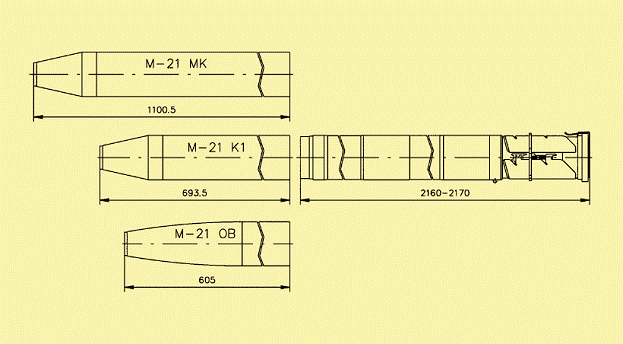
The general data of the rocket part are as follows: engine weight - 41.7 kg, engine run time - 2-3 seconds, maximum speed - 600 m/s, application temperature -40 - +50 ° C.
Volume of wooden box for one projectile - 0.06÷0.10 cubic meters. Gross weight - 100÷ 110 kg.
Below are the data of the Feniks-Z caliber 122 mm unguided rockets with one type of rocket engine with mixed solid propellant and head units with the same dimensions as in the first projectiles:
- The M-21 FHE 18.4 kg FHE shrapnel-head projectile with 6000 effective shrapnel pieces. The range of the projectile was increased to more or equal to 42,000 m. The length of the head unit without a fuse - 605 mm, the length of the missile part - 1983 mm.
- The projectile with the M-21 FK cluster head weighing 23.5 kg with 42 cumulative shrapnel warheads. Each combat unit weighs 342 g, its diameter is 38 mm, and it is capable of penetrating 120 mm of armor. It is a shock-activated detonator. Self-liquidation time 22±5 sec. The length of the head unit without the fuse - 693.5 mm, the length of the missile unit - 1983 mm. The projectile's range of flight is more or equal to 32,000 m.
- The M-21 FK1 25.6 kg cassette warhead projectile with five MN-121 anti-tank mines. The mine density is 1 mine per 250 square metres. The length of the head unit without a fuse is 1100.5 mm, the length of the missile unit is 1983 mm. The projectile's range of flight is more or equal to 30,000 m.
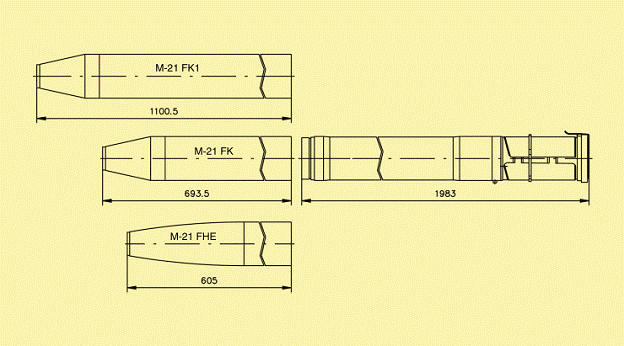
The general data of the rocket part are as follows: the weight of the engine - 41.7 kg, engine run time - 2.9-3.3 sec, maximum speed - 1250 m/s, temperature of application - 30 - +50 ° C.
Volume of wooden box for one projectile - 0.20÷0.22 cubic meters. Gross weight - 90÷100 kg.
By the end of the 2000s there was information about the work carried out in Poland to increase the maximum range of 122 mm shells. It is assumed that for the projectile with a conventional (shrapnel-type) head part it will be 65,000 m and for the projectile with a cassette head part it will be 45,000 m.
Composition:
The HQ-12 SAMs are included:
- anti-aircraft guided missiles (SAMs) (see photo);
- launchers (see photo1, photo2, photo3);
- H-200 multifunction illumination and pointing radar;
- means of technical operation (transport and charging machines, etc.) (see Photo 1, Photo 2).
Single-stage LSD HQ-12 (see diagram) is made according to the normal aerodynamic scheme. The casing of the rocket cylindrical in diameter 400 mm, equipped with four wings, in the tail of the body are four aerodynamic rudders. The length of the rocket - 5.6m, the starting weight of 886kg. The missile's marching engine is a two-mode solid fuel. The missile's shrapnel-type combat unit weighs 100 kg and is equipped with a radio detonator. Maximum flight speed of the rocket - 1200m / s, located overload 20g. Control system - radio command. The missile is designed primarily to defeat aircraft and helicopters and has limited combat capabilities against modern high-precision means of attack class "air-ground" and UAV.
Launch of the missile is inclined, with the launcher facing the corner of the place and azimuth. The transported four-supported KS-1 missile launcher is a modified version of the HQ-2 SAM system and has two rails. The modernized mobile PU of KS-1A complex is placed on the cross-country vehicle chassis with the wheel arrangement 6x6. PU KS-1A also has two guideways of rail type with lower missile suspension (see photo1, photo2, photo3). When deployed in combat position, the PU is mounted on hydraulic supports. Images of the KS-1A version with box-type launch containers (see photo) were published, protecting the missiles from external influences and facilitating maintenance and charging.
Target tracking and guidance station SJ-202 of KS-1 complex is a three-axis radar, which allows you to simultaneously accompany six targets and point at three of them 6 SAMs. It was reported that the station is most likely to operate in the G-band. The radar antenna is transported on a trailer. The SJ-202 radar can paired with the HQ-2 complex.
The improved version of the KS-1A air defense system differs from its prototype by the use of a new illumination and pointing radar H-200 instead of SJ-202. Multifunctional radar illumination and pointing H-200 consists of an antenna station, placed on a four-axle trailer (see photo), and a hardware container on the chassis of Taian TA5150A cross-country vehicle with the wheel arrangement 6x6 (see photo). Later, there were versions of this radar, placed on two Taian TA5270A (6x6) trucks. The antenna device of the H-200 radar is a phased antenna array of circular rotation with digital control of the beam position, which is similar in size to that of the HT-233 radar of the HQ-9 complex. The instrumental range of target detection is 115km, escort is 80km. H-200 provides simultaneous targeting of six missiles at three targets. According to the developers, the H-200 radar implements advanced data processing methods that provide effective target selection and protection against electronic suppression means. The station is equipped with a system of identification of "one's own", an autonomous power supply source and radio communications.
The typical battery of the complex includes radars for missile detection and guidance, four launchers with 8 SAMs and 18 missiles in ammunition. Some sources of the battery can be assigned to the HQ-9 Type-120 low-flying target detection radar.
Characteristics:
| A prototype of an automated combat vehicle (Star chassis) | |
| Chassis type | Star |
| Length, mm | 7400 |
| Width, mm | 2500 |
| Height, mm | 3000 |
| Combat vehicle weight, kg | 14 000 |
| The depth of the ford to be overcome, mm | 1200 |
| Maximum speed on paved roads, km/h. | 86 |
| Installation time of 40 fuses of shells in the launcher, min. | maximum 3 |
| Full salvo time, s | 20 |
| Calculation, man. | 1-5 |
| Operating temperature range, ºC | -30 - +50 |
| Number of tubular rails, pcs. | 40 |
| Inner diameter of the guideway, mm | 122,4 |
| Angle of elevation, deg: | |
| minimum | 0 |
| maximum | +55 |
| Angle of horizontal fire, deg: | |
| to the right of the chassis axle | 70 |
| to the left of the driving axle | 102 |
| Car bypass angle, deg. | 40 |
| Smallest elevation angle in the cockpit area, deg | 14 |
| Positioning speed by electric drive, deg/s: | |
| aloft | up to 7 |
| azimuthally | up to 5 |
| Manual drive speed per handwheel revolution: | |
| aloft | up to 6' |
| azimuthally | up to 4' |
| Chassis data of the prototype automated combat vehicle | |
| Load capacity, kg | 6 000 |
| Cabin type | six-man, caravan, hydraulic lift |
| Engine model | D2156 HMN8 or DO 826 LFG15 |
| Motor type | diesel |
| Number of cylinders, pcs. | 6 |
| Engine power, kW | 162 |
| Speed per minute at this capacity | 2400 |
| Power reserve, km | 650 |
| Data from a prototype of an automated combat vehicle WR-40 Langusta | |
| Chassis type | Jelcz P662D.35 |
| Length, mm | 8588 |
| Width, mm | 2540 |
| Height in hiking position, mm | 2740 |
| Weight of the combat vehicle (without shells and calculation numbers), kg | 17 000 |
| Maximum combat weight, kg | 20 150 |
| The depth of the ford to be overcome, mm | 1200 |
| Gradient overridden in forward travel, º | 36 |
| Gradient overcome in reverse, º | 36 |
| Permissible side slope steepness, º | 20 |
| Overcoming Lift, º/% | 30/60 |
| Maximum travel speed, km/h | up to 85 |
| Full salvo time, s | 20 |
| Navigation system TALIN 4000 | developed by Honeywell (USA). |
| Radio station | Radmor RRC-9310P, wavelength range |
| Cabin ballistic protection | STANAG-4569 level 1 |
| Programmable electronic fuse device | EP-100 developed by the Polish Military Institute of Ammunition WITU |
| Number of tubular rails, pcs. | 40 |
| Inner diameter of the guideway, mm | 122,4 |
| Angle of elevation, deg: | |
| minimum | 0 |
| maximum | +55 |
| within the cabin area | 11 |
| Angle of horizontal fire, deg: | |
| to the right of the chassis axle | 70 |
| to the left of the driving axle | 102 |
| Positioning speed by electric drive, deg/s: | |
| aloft | up to 7 |
| azimuthally | up to 5 |
| Manual drive speed by one turn of the flywheel: | |
| aloft | up to 6' |
| azimuthally | up to 4' |
| WR-40 Langusta automatic combat vehicle prototype chassis data | |
| Load capacity, kg | 10 000 |
| Cabin type | six-seater |
| Engine model | Aifo Cursor 8, standard EURO 3 |
| Motor type | diesel |
| Engine power, kW (HP) | 259 (350) |
| Internal engine volume, cube dm. | 350 |
| Power reserve, km | 650 |
| Traffic clearance, mm | 410 |
Testing:
As of 01.01.1950, the factory batch of 230 shells was completed and sent to the Pavlograd test site.
In November 1949, pre-factory tests of 34 shells were carried out together with the fuse B-377 during which cases of missiles were revealed.
Special tests carried out to determine the causes of deficits showed that the most probable cause was an increased release of unburned reactive charge particles at the end of the active section of the trajectory.
In order to eliminate this phenomenon, in December 1949 a bench-top refinement of the engine was started with regard to aperture enhancement and ensuring that the powder charge was fixed in the chamber. After the end of the bench work and experimental firing for checking the reinforced aperture, the factory batch of projectiles was to be equipped with modified apertures on site and presented for factory tests in February 1950.
Sources:
- Рекламный листок по автоматизированной боевой машине на шасси Star.
- Рекламный листок по автоматизированной боевой машине WR-40 Langusta.
- Фото© и дополнительная информация Томас Шульц (Tomasz Szulc, Польша, 2008 год)
- Фото© Мирослав Дюроши (Miroslav Gyürösi, Словакия, 2008 год)
- Bumar Group. Defence Equipment Catalogue. IDELF 2006. 122mm Extended Range PHENIX Rocket for BM-21/RM-70 Launcher.
- Bumar Group. Defence Equipment Catalogue. IDELF 2006. 122mm Rocket for BM-21/RM-70 Launcher.
- Holdanowicz Grzegorz. Feniks-Z 122mm rocket passes qualifying tests. // Jane’s defence weekly. – 24 October 2001. – Vol. 36. – № 17. – P. 30.
- Grzegorz Holdanowicz. Poland orders Feniks-Z artillery rockets. // Jane’s MISSILES&rockets. Incorporating precision guided munitions – February 2004. – Vol. 8. – № 2. – P. 10.
- Polski Przemysł Obrony. – 2003. – P. 71-72.
- www.military-today.com
- http://en.wikipedia.org/wiki/WR-40_Langusta
- http://www.aadd2.com/vb/showthread.php?t=87492

